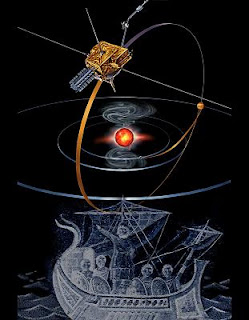The travels of Ulysses

______________________________________________________
Less than one hundred years ago, the south pole of Earth was a land of utter mystery. It was terra incognita until intrepid Explorers Roald Amundsen and Robert F. Scott, fighting wind, disorientation and a fantastic almost-martian cold reached the Pole in 1911 and 1912
The situation is much the same today on the sun. "The sun's south pole is uncharted territory," says solar physicist Arik Posner of NASA headquarters. "We can barely see it from Earth, and most of our sun-studying spacecraft are stationed over the sun's equator with a poor view of higher latitudes."
There is, however, one spacecraft that can travel over the sun's poles. "On February 7th, Ulysses reached a maximum heliographic latitude of 80 degrees South - almost directly above the South Pole," says Posner who is the Ulysses Program Scientist for NASA.
Ulysses has flown over the sun's poles only twice before--in 1994-95 and 2000-01. The flybys were brief, but enough to prove that the poles are strange and interesting places.
Consider the following:
1. The sun's north magnetic north pole sticks out the south end of the sun. Magnetically, the sun is upside down!
"Most people don't know it, but we have the same situation here on Earth," notes Posner. "Our magnetic north pole sticks out of the geographic south pole."
"Both the sun's and Earth's magnetic poles are constantly on the move, and they occasionally do a complete flip, with N and S changing places."
This flipping happens every 11 years on the sun in synch with the sunspot cycle. It happens every 300,000 years or so on Earth in synch with--what? No one knows. "Studying the polar magnetic field of the sun might give us some clues about the magnetic field of our own planet."
2. There are coronal holes over the sun's pole. These are places where the sun's magnetic field opens up and allows solar wind to escape. "Flying over the sun's poles, you get slapped in the face by a hot, million mph stream of protons and electrons," Ulysses is experiencing and studying this polar wind right now.
3. Something keeps cosmic rays out of the sun's polar regions. The current flyby gives us a chance to investigate this phenomenon.
4. Another mystery: There is evidence from earlier flybys that the north pole and the south pole of the sun have different temperatures. "We're not sure why this should be," says Posner, "and we're anxious to learn if it is still the case." Today's south polar flyby will be followed by a north polar flyby in early 2008, allowing a direct north vs. south comparison.
 Today the spacecraft Ulysses is gliding 300 million km (2 AU) above the sun's 'Antarctic.'
Today the spacecraft Ulysses is gliding 300 million km (2 AU) above the sun's 'Antarctic.'That's a safe distance and a good place to sample the sun's polar winds and magnetic fields.
______________________________________________________
Ulysses - Exploring Space over the Sun's Poles from ESA
Deep Space Voyage to High Latitudes over the Solar Poles. from NASA
______________________________________________________
______________________________________________________
On matters closer to Earth. I shall soon (next month) be starting a closer scrutiny of medical advances, standards in health care and nhs practices in Cambridge on the other site Torchwood
______________________________________________________
______________________________________________________


<< Home